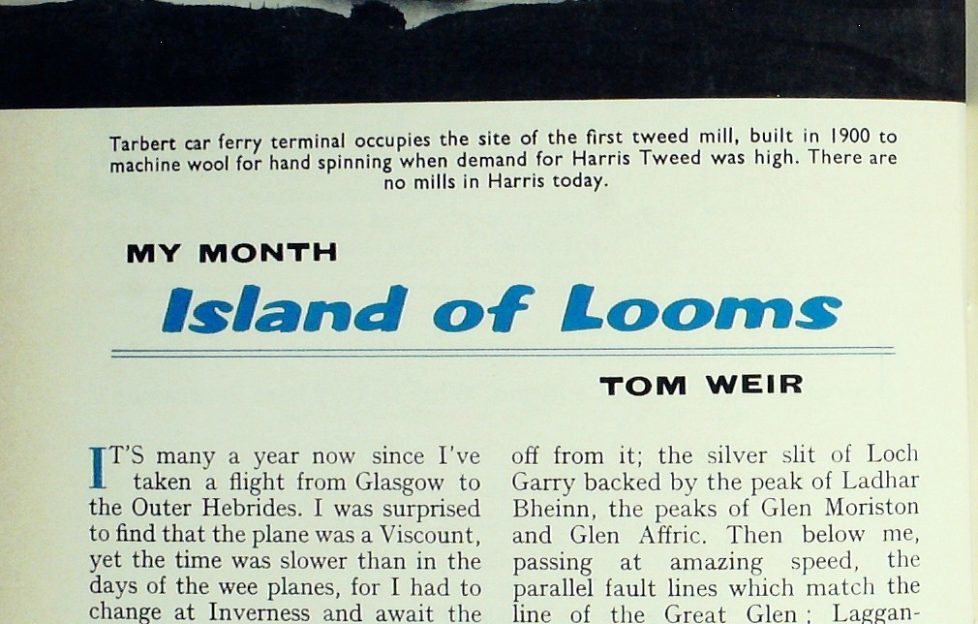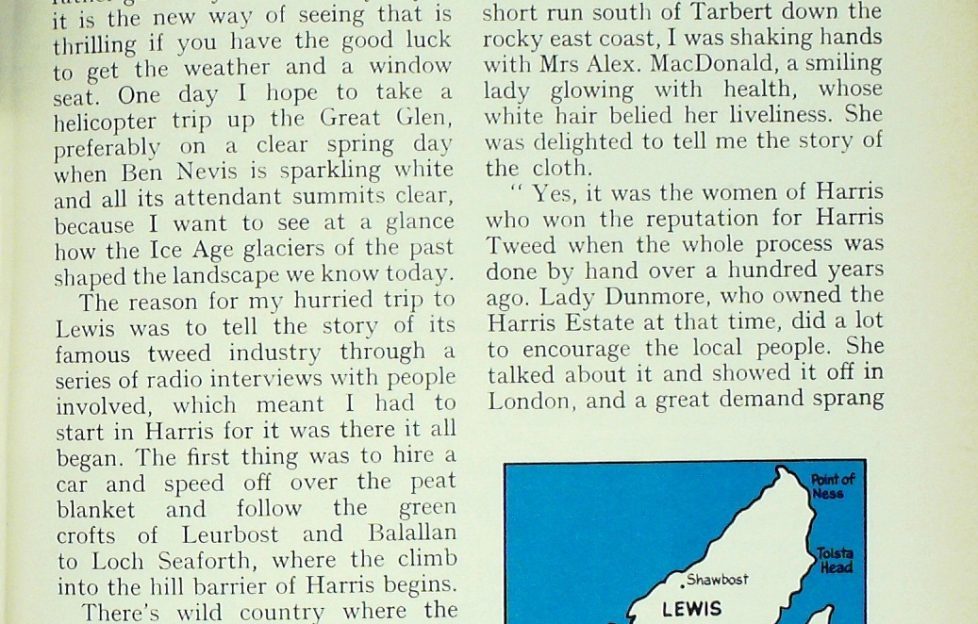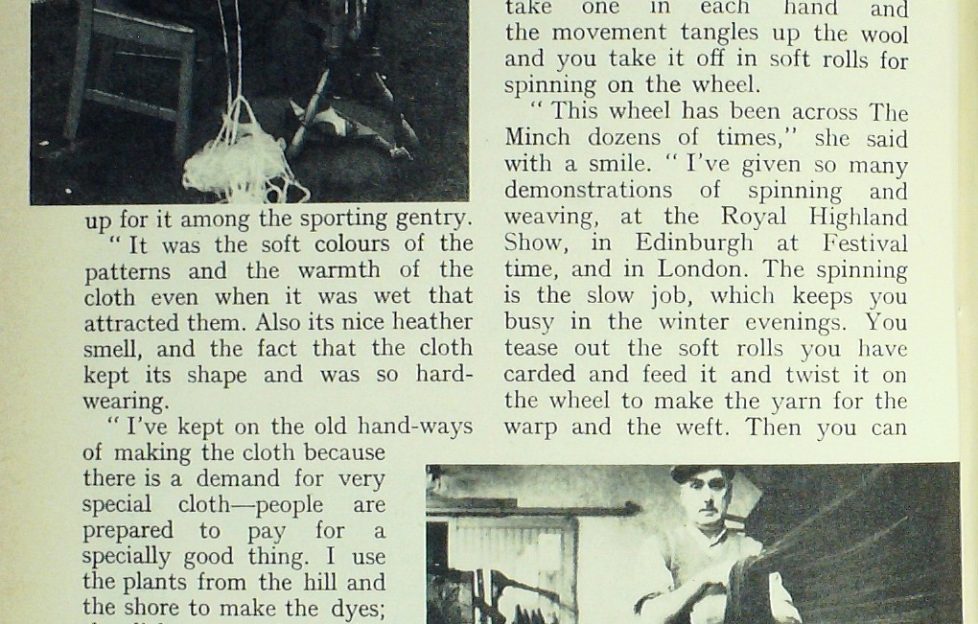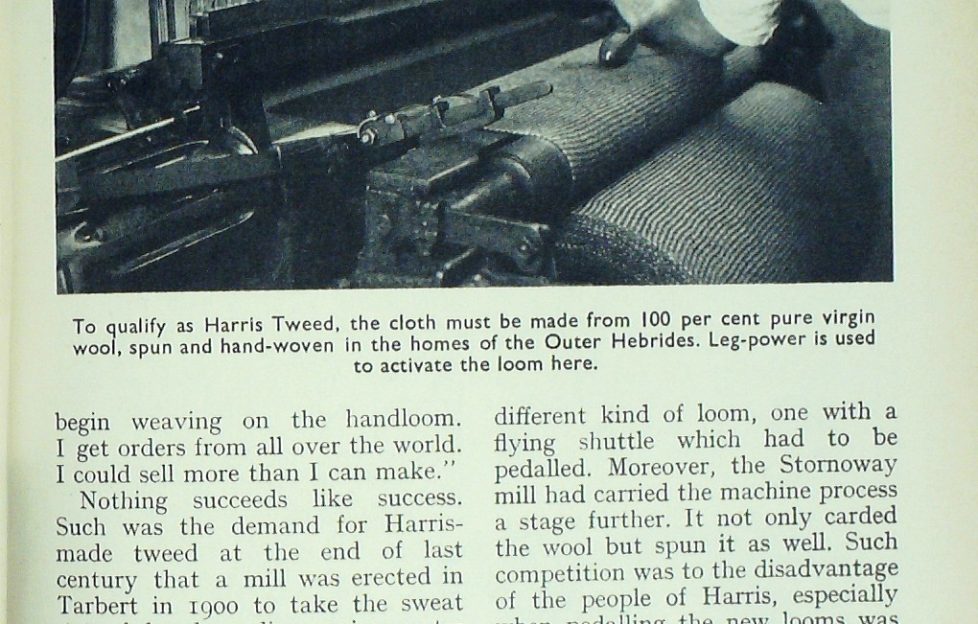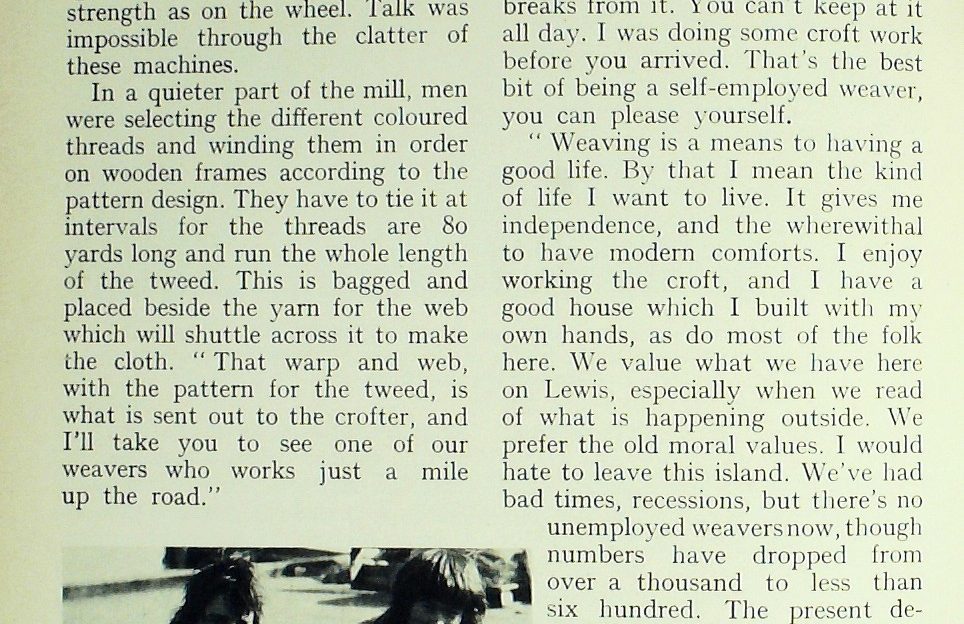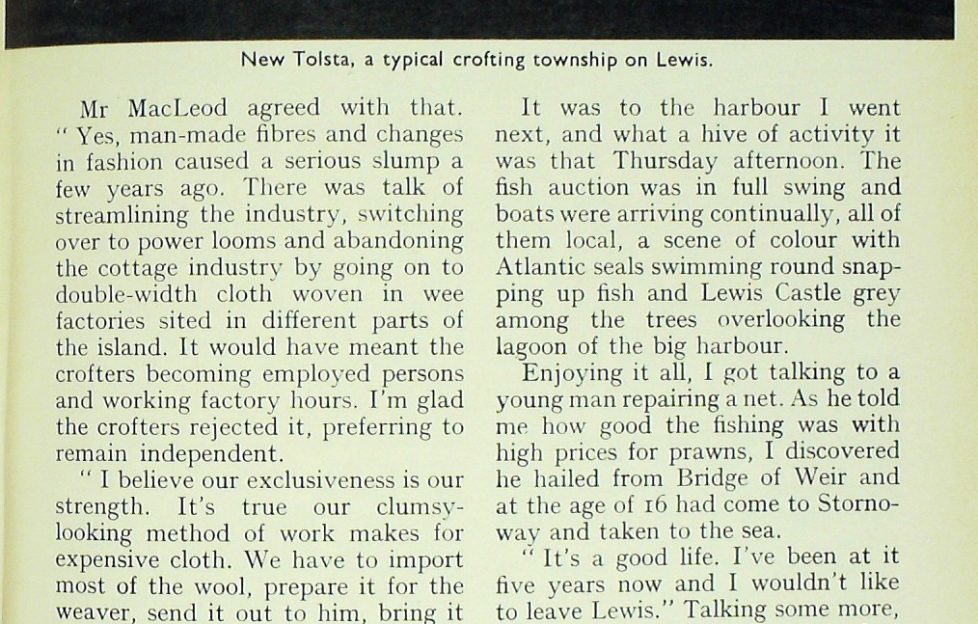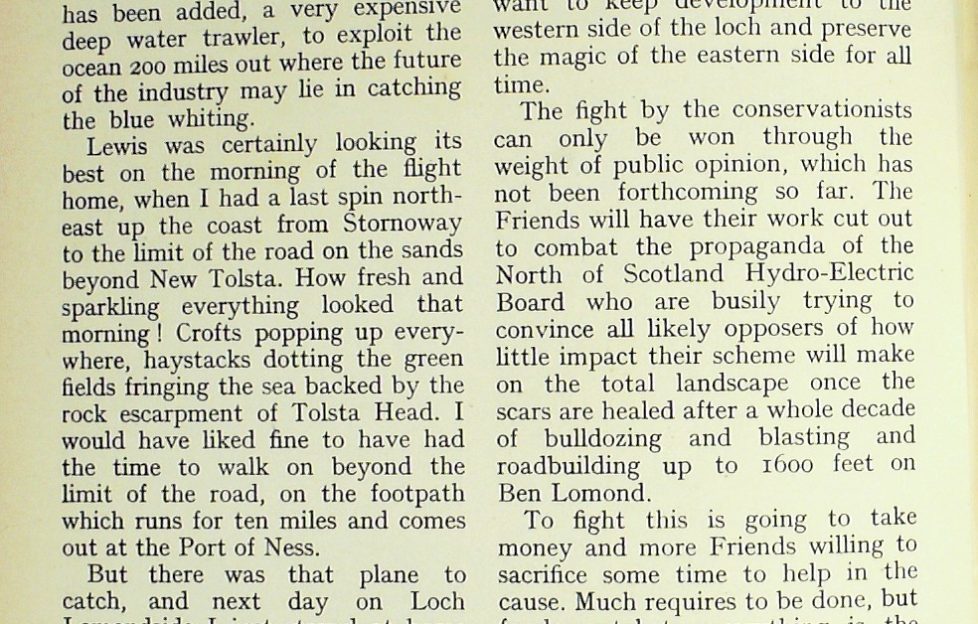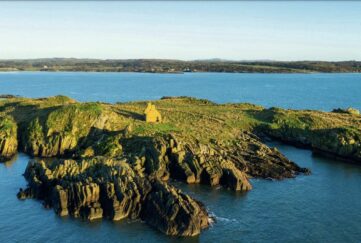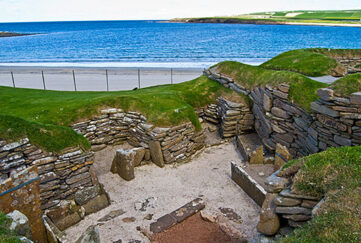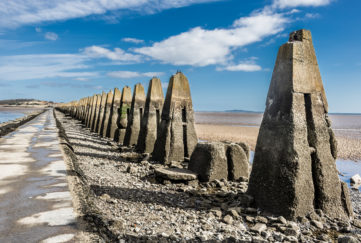Tom Weir | Island of Looms
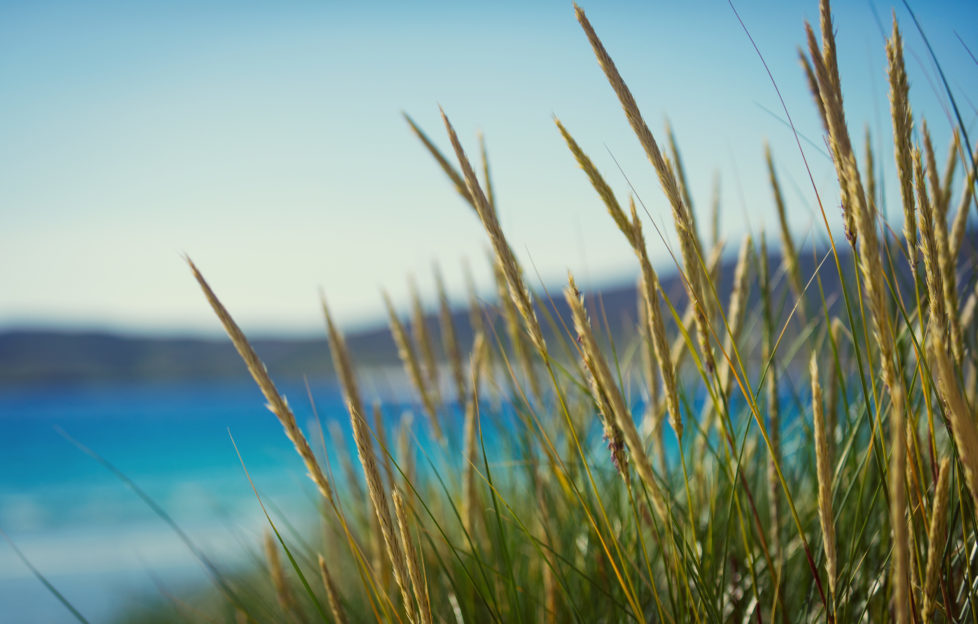
In his last column from 1978, Tom Weir follows the history of Harris Tweed and supported the creation of the Friends of Loch Lomond group…
It’s many a year now since I’ve taken a flight from Glasgow to the Outer Hebrides. I was surprised to find that the plane was a Viscount, yet the time was slower than in the days of the wee planes, for I had to change at Inverness and await the arrival of the London flight and transfer to it. Total time from Glasgow to Stornoway, 3 and a half hours— such is progress. In the old days it took half the time.
Still, I’m not complaining, for the journey back was the most exciting I’ve ever had in Scotland, especially the part from Inverness to Glasgow, flying parallel and just a bit east of the Great Glen that splits the Highlands from North Sea to Atlantic.
It was fascinating to see all the passes to the west that cut off from it; the silver slit of Loch Garry backed by the peak of Ladhar Bheinn, the peaks of Glen Moriston and Glen Affric. Then below me, passing at amazing speed, the parallel fault lines which match the line of the Great Glen; Laggan-Ericht-Laidon, Rannoch Moor, the Tyndrum and Loch Tay basins pin-pointed by their peaks.
Hard to take it all in. Westward I could see the island hills and gleaming bits of sea, but the colours were monochromatic, until the plane began losing height, and over the Trossachs the prickly hills and wooded lochs were as brilliant as in a colour transparency. It was like looking down on some wonderful and constantly changing relief map.
I could see the southern shore of Loch Lomond and my own village, then sliding down over the green Kilpatricks and banking over the Clydebank cranes, I looked down-river to the Arran hills. It hardly had time to register before the plane was racing over the runway and we were descending into evening sunlight at Glasgow Airport.
Part of the pleasure of that trip was because I knew the country so intimately. It is not the flying that is enjoyable, or the speed of it—I’d rather go slowly overland any day— it is the new way of seeing that is thrilling if you have the good luck to get the weather and a window seat. One day I hope to take a helicopter trip up the Great Glen, preferably on a clear spring day when Ben Nevis is sparkling white and all its attendant summits clear, because I want to see at a glance how the Ice Age glaciers of the past shaped the landscape we know today.
The reason for my hurried trip to Lewis was to tell the story of its famous tweed industry through a series of radio interviews with people involved, which meant I had to start in Harris for it was there it all began. The first thing was to hire a car and speed off over the peat blanket and follow the green crofts of Leurbost and Balallan to Loch Seaforth, where the climb into the hill barrier of Harris begins.
There’s wild country where the road crosses the Clisham, highest of the fine peaks stretching west to the silver sands of Husinish. Between gleams of sun, clouds were scudding along the splintered crags, with Glen Laxdale far below. I swung the car down to Ardhasig and followed the coast into Tarbert, perched on its rocky shore between the two sea lochs which almost pinch off South Harris from North Harris.
A Unique Kind of Cloth
I’ve always liked the wee town that sits in that narrow neck between the West Loch and the East Loch. The hard rock that rises all round it tells its own story of sterile land incapable of supporting any but a small and vigorous population. Perhaps it could have been a fishing empire, which was the dream of Lord Leverhulme, but long before his time its people had become renowned as weavers of a unique kind of cloth— Harris Tweed.
The story of Harris Tweed, which today is a monopoly of Lewis, began here at Drinesheader, and after a short run south of Tarbert down the rocky east coast, I was shaking hands with Mrs Alex. MacDonald, a smiling lady glowing with health, whose white hair belied her liveliness. She was delighted to tell me the story of the cloth.
“Yes, it was the women of Harris who won the reputation for Harris Tweed when the whole process was done by hand over a hundred years ago. Lady Dunmore, who owned the Harris Estate at that time, did a lot to encourage the local people. She talked about it and showed it off in London, and a great demand sprang up for it among the sporting gentry.
“It was the soft colours of the patterns and the warmth of the cloth even when it was wet that attracted them. Also its nice heather smell, and the fact that the cloth kept its shape and was so hard- wearing.
“I’ve kept on the old hand-ways of making the cloth because there is a demand for very special cloth—people are prepared to pay for a specially good thing. I use the plants from the hill and the shore to make the dyes; the lichens on the rocks, water lily leaves from the ponds, dandelions, bracken, yellow iris, even soot from the chimney. You can look at these fleeces which I dye in batches to get my colours for the pattern. Then it has to be carded, scraped back and fore between the wire teeth of these flat boards. You take one in each hand and the movement tangles up the wool and you take it off in soft rolls for spinning on the wheel.
“This wheel has been across The Minch dozens of times,” she said with a smile. ” I’ve given so many demonstrations of spinning and weaving, at the Royal Highland Show, in Edinburgh at Festival time, and in London. The spinning is the slow job, which keeps you busy in the winter evenings. You tease out the soft rolls you have carded and feed it and twist it on the wheel to make the yarn for the warp and the weft. Then you can begin weaving on the handloom. I get orders from all over the world. I could sell more than I can make.”
Nothing Succeeds Like Success.
Such was the demand for Harris-made tweed at the end of last century that a mill was erected in Tarbert in 1900 to take the sweat out of hand carding, using water power and machinery to prepare the wool for the spinning-wheel and enable the crofters to meet the rising demand for their cloth.
By that time, however, the folk just across the border in Lewis were taking up weaving, and by 1903 a mill had been set up in Stornoway as in Tarbert, and still the demand for the cloth outstripped the supply. Within the next seven years ownership of looms in Lewis had risen six-fold and they were using a different kind of loom, one with a flying shuttle which had to be pedalled.
Moreover, the Stornoway mill had carried the machine process a stage further. It not only carded the wool but spun it as well. Such competition was to the disadvantage of the people of Harris, especially when pedalling the new looms was work for men demanding muscle and strong legs. In time Lewis was to be the home of Harris Tweed- making.
So I would have to return over the Harris border now and resume my quest where the byroads lead by the Callanish Stones and Carloway Broch to the busy townships of Shawbost. My target was Kenneth MacLeod’s mill, strategically centred among some of Lewis’s busiest crofters and weavers.
A Noisy Business
Arriving unannounced, I expected to have to fix an appointment to be shown round and have the relationship between the mill and the home-weaver explained.
Not a bit of it. One of the busy directors left what he was doing to take me on a conducted tour, following the dyed fleeces through the whole process, from the mixing and blending of the different coloured wools to the lifting up of the multi-coloured piles for machine carding on toothed rollers, then on to spindles to give the yarn twist and strength as on the wheel. Talk was impossible through the clatter of these machines.
In a quieter part of the mill, men were selecting the different coloured threads and winding them in order on wooden frames according to the pattern design. They have to tie it at intervals for the threads are 80 yards long and run the whole length of the tweed. This is bagged and placed beside the yarn for the web which will shuttle across it to make the cloth.
“That warp and web, with the pattern for the tweed, is what is sent out to the crofter, and I’ll take you to see one of our weavers who works just a mile up the road.”
Even fifty yards from the shed we could hear the clatter of the loom as we got out of the car a few minutes later. The silence was welcome when Malcolm Campbell looked up, saw us and stopped pedalling.
Alas, he looked at me as if l was daft when I asked him if he enjoyed the work.
“Look,” he said, drawing up his trouser legs to show me his varicose veins. “That’s what you get working the loom. I hate it. It’s strenuous, monotonous, noisy work. You have to take a few wee breaks from it. You can’t keep at it all day. I was doing some croft work before you arrived. That’s the best bit of being a self-employed weaver, you can please yourself.
“Weaving is a means to having a good life. By that I mean the kind of life I want to live. It gives me independence, and the wherewithal to have modern comforts. I enjoy working the croft, and I have a good house which I built with my own hands, as do most of the folk here. We value what we have here on Lewis, especially when we read of what is happening outside. We prefer the old moral values. I would hate to leave this island. We’ve had bad times, recessions, but there’s no unemployed weavers now, though numbers have dropped from over a thousand to less than six hundred. The present demand could put the numbers up.”
Mr MacLeod agreed with that.
“Yes, man-made fibres and changes in fashion caused a serious slump a few years ago. There was talk of streamlining the industry, switching over to power looms and abandoning the cottage industry by going on to double-width cloth woven in wee factories sited in different parts of the island. It would have meant the crofters becoming employed persons and working factory hours. I’m glad the crofters rejected it, preferring to remain independent.”
“Our exclusiveness is our strength.”
“It’s true our clumsy-looking method of work makes for expensive cloth. We have to import most of the wool, prepare it for the weaver, send it out to him, bring it back to remove the grease and make the tweed soft and close. Then we inspect it to make sure it is worthy of the coveted Orb mark.
“It all works out right in the end though, for we have a cloth which is unique in the world—and people are prepared to pay for it. We’ve moved with the times, the cloth comes in a variety of weights and the range of patterns is limitless. Two-thirds of what we produce on this island will be sent abroad in bales from Stornoway Harbour.”
It was to the harbour I went next, and what a hive of activity it was that Thursday afternoon. The fish auction was in full swing and boats were arriving continually, all of them local, a scene of colour with Atlantic seals swimming round snapping up fish and Lewis Castle grey among the trees overlooking the lagoon of the big harbour.
Enjoying it all, I got talking to a young man repairing a net. As he told me how good the fishing was with high prices for prawns, I discovered he hailed from Bridge of Weir and at the age of 16 had come to Stornoway and taken to the sea.
“It’s a good life. I’ve been at it five years now and I wouldn’t like to leave Lewis.” Talking some more, I asked him what chances he had of having his own boat one day, of being a skipper. He smiled. “That’s my boat, the Girl Isobel. She’s just under 59 feet. I bought her second-hand on a bank loan. I couldn’t get a grant because she was too ancient. I studied for my ticket up at the Castle, but I’m not allowed to sail anything over 50 tons. I’ve a long way to go yet.”
I complimented him on his enterprise and took a note of his name, Scott McLean, so that I could send him a photograph of himself along with a member of his crew, 21-year- old William John MacDonald, a time-served plumber. Like me, William is not a particularly good sailor, and how he gets on as a fisherman will determine whether or not he will stick it.
Stornoway has a modern fleet of about 40 boats, most of them obtained with help from the Highlands and Islands Development Board under their very successful fisheries scheme. Now a new boat has been added, a very expensive deep water trawler, to exploit the ocean 200 miles out where the future of the industry may lie in catching the blue whiting.
Lewis was certainly looking its best on the morning of the flight home, when I had a last spin north-east up the coast from Stornoway to the limit of the road on the sands beyond New Tolsta. How fresh and sparkling everything looked that morning! Crofts popping up everywhere, haystacks dotting the green fields fringing the sea backed by the rock escarpment of Tolsta Head. I would have liked fine to have had the time to walk on beyond the limit of the road, on the footpath which runs for ten miles and comes out at the Port of Ness.
But there was that plane to catch, and next day on Loch Lomondside I just stayed at home in order to digest the experience and enjoy a sunny day of warmth on the shore. How lovely it was down on the yellow reed beds of the marsh, watching a pair of sparrow hawks circling in play, escorted by about 500 meadow pipits flitting about them like gnats. In fact, the birdlife was exceptionally good, for a few days later we had no less than 14 little stints and three spotted redshanks.
The Origins of an Institution
The best thing that has happened recently in our part of the world is the formation of a “Friends of Loch Lomond” society, rather similar to the “Friends of The Lake District,” which has been such a good watchdog in England.
The object is to involve the public in all matters concerning the loch and its shores, the most important issue at the moment being the Ben Lomond Hydro-Electric Scheme which the Hydro-Board like to disguise under the name Craigroyston. The Friends want to keep development to the western side of the loch and preserve the magic of the eastern side for all time.
The fight by the conservationists can only be won through the weight of public opinion, which has not been forthcoming so far. The Friends will have their work cut out to combat the propaganda of the North of Scotland Hydro-Electric Board who are busily trying to convince all likely opposers of how little impact their scheme will make on the total landscape once the scars are healed after a whole decade of bulldozing and blasting and road-building up to 1600 feet on Ben Lomond.
To fight this is going to take money and more Friends willing to sacrifice some time to help in the cause. Much requires to be done, but fundamental to everything is the muscle of a big membership to show the Secretary of State for Scotland that the Society means the people and not just a handful of cranks. If you wish to join, the cost is £2 and cheques should be payable to “Friends of Loch Lomond,” and sent to:
Mr I. C. MacArthur,
Bank of Scotland,
26 Colquhoun Square,
Helensburgh, G84 SAP.
Note: The above petition and campaign by the Friends of Loch Lomond collected some 200,000 signatures against the pumped storage scheme, and the proposal was eventually shelved. The group is still going strong, and continues to protect the natural beauty of the Loch Lomond area for future generations.
More information on the Friends can be found on their website, and donations can be made here.
More columns…
Read more from Tom!
We have an extensive archives of Tom Weir’s great columns for The Scots Magazine, and we’re slowly but surely getting them published digitally for new generations to enjoy.
To see the columns we have online so far, click here.


